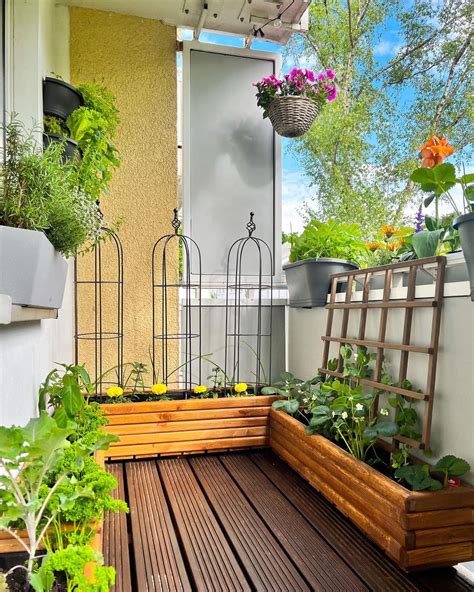Maximizing Yield: A Comprehensive Guide to Planning Your Balcony Garden
Balcony gardening has become a popular option for urban dwellers who want to grow their own food and flowers in limited spaces. With the right strategies, you can transform a small balcony into a highly productive and beautiful outdoor oasis. This guide will walk you through key steps for designing and planning a successful balcony garden that maximizes yield while considering sustainability, aesthetics, and ease of maintenance.
Introduction
Whether you’re a gardening novice or an experienced urban farmer, planning a balcony garden requires careful thought about space utilization, plant selection, and environmental factors. To create a garden that not only thrives but also maximizes productivity, it’s essential to blend creativity with practicality. In this guide, we’ll discuss key concepts such as container gardening, efficient use of space, and crop rotation strategies for maximizing your garden’s yield.
Key Concepts
- Container Gardening: Utilizing pots, planters, and vertical structures to grow plants in confined spaces.
- Vertical Gardening: Using walls and railings to grow climbing plants or stack planters to save space.
- Microclimate Management: Understanding how sunlight, wind, and rain affect the conditions on your balcony.
- Companion Planting: Grouping compatible plants together to encourage growth and natural pest control.
- Soil Quality: Ensuring the right balance of nutrients, water retention, and drainage in your containers.
- Water Management: Efficiently managing water resources, especially important in container gardening.
Historical Context
Balcony gardening has ancient roots. In urban areas of Ancient Rome and Babylon, elevated gardens were cultivated as decorative and functional spaces. The Hanging Gardens of Babylon are often considered one of the earliest forms of urban gardening. Over time, the need for urban gardening has resurfaced, particularly as cities have grown more populated and outdoor spaces have become limited. Today, urban gardening trends, like container and vertical gardening, owe much to these historical precedents while incorporating modern techniques to maximize yield.
Current State Analysis
In today’s densely populated urban environments, balcony gardening offers a solution for those who wish to grow their own food or flowers but lack access to a full garden plot. With increased awareness about sustainability and food security, more people are turning to urban gardening. The availability of innovative gardening tools and materials, such as self-watering planters and lightweight potting mixes, has made balcony gardening accessible and efficient for both novice and experienced gardeners.
Challenges: Limited space, exposure to harsh weather conditions, and the need for frequent watering in containers can be hurdles. However, with proper planning, these issues can be mitigated to create a productive and beautiful garden.
Practical Applications
Implementing a successful balcony garden requires careful selection of plants, attention to sunlight patterns, and maximizing vertical space. Here are some practical tips:
- Plan your space: Measure your balcony and plan for a combination of small pots, large planters, and vertical structures. Use every inch wisely by utilizing railings and walls.
- Choose the right plants: Consider your local climate and how much sun your balcony gets. Plants such as tomatoes, herbs, and leafy greens thrive in containers, while climbing plants like beans and cucumbers can grow vertically.
- Use lightweight soil: Select potting soil that is rich in nutrients but lightweight for easy handling and good drainage.
- Install a drip irrigation system: Watering can be a challenge in container gardening. A drip irrigation system can help ensure your plants receive consistent moisture.
- Rotate crops: Avoid depleting soil nutrients by rotating crops between seasons. This also helps manage pests and diseases.
Case Studies
Several urban gardeners have successfully transformed their balconies into productive garden spaces. The following table highlights key strategies employed in different scenarios:
| Gardener | Location | Strategies Used | Result |
|---|---|---|---|
| Emily S. | New York, USA | Vertical gardening, container rotation, drip irrigation | Increased vegetable yield by 40% in one season |
| Mark J. | Toronto, Canada | Companion planting, lightweight soil, grow lights for winter | Achieved year-round harvest of herbs and greens |
| Hiroko M. | Tokyo, Japan | Maximized space with rail-mounted planters, water conservation techniques | Reduced water usage by 30% while maintaining healthy plants |
Stakeholder Analysis
Key stakeholders in balcony gardening include urban residents, landlords, city planners, and environmental organizations. Balcony gardening can contribute to urban greening efforts, improve mental health for residents, and offer a solution for those concerned about food security. By engaging all stakeholders in the planning process, it’s possible to create balcony gardens that are sustainable, productive, and socially responsible.
Implementation Guidelines
To start a balcony garden, follow these steps:
- Assess your space: Evaluate the size, sunlight exposure, and wind conditions of your balcony. Make note of any weight restrictions for containers and planters.
- Choose your plants: Select plants that are suited to your local climate and the microclimate of your balcony. Herbs, small vegetables, and trailing plants are ideal for small spaces.
- Select containers: Invest in lightweight, durable containers with proper drainage. Consider self-watering planters to reduce maintenance.
- Prepare the soil: Use high-quality, nutrient-rich potting soil that retains moisture but drains well.
- Install a watering system: Set up a drip irrigation system or use watering schedules to ensure consistent hydration for your plants.
- Monitor and adjust: Regularly check plant growth and adjust watering, soil, or plant placement as needed.
Ethical Considerations
While balcony gardening offers numerous benefits, there are also ethical considerations to keep in mind. Overuse of water and synthetic fertilizers can negatively impact the environment. To garden ethically, consider water conservation techniques such as rainwater harvesting, use organic fertilizers, and avoid using harmful pesticides.
Limitations and Future Research
While balcony gardening is a viable solution for urban dwellers, limitations include space constraints, weight restrictions on balconies, and challenges with sunlight exposure. Future research could explore innovations in container materials, sustainable irrigation systems, and new methods for maximizing vertical space in small urban environments.
Expert Commentary
As experts in urban gardening point out, maximizing yield on a balcony garden is a blend of creativity, resourcefulness, and solid planning. Successful gardeners must adapt to the specific limitations and opportunities of their space, making the most of natural sunlight, efficient watering systems, and plant selection. The future of balcony gardening lies in integrating smart technology to monitor plant health, conserve resources, and increase productivity without sacrificing aesthetics or sustainability.


